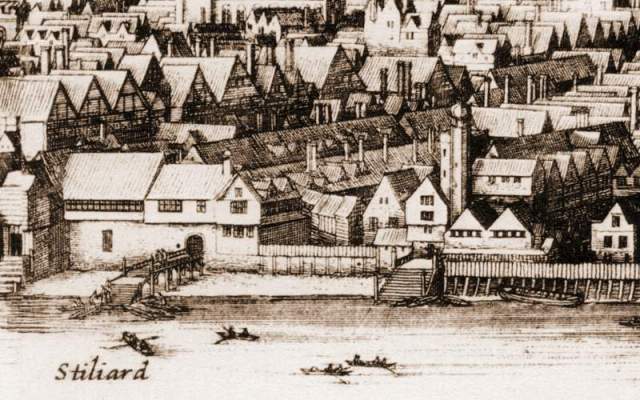Above: Part of Hollar’s panorama of the City of London of 1646, showing the buildings of the Steelyard beside the Thames.
“Upper Thames Street”
The origins of The Steelyard go back to Saxon times. Foreign merchants were encouraged to trade with England by the English kings. The earliest traders were Norman wine merchants from Rouen who were established beside the Thames near today’s Dowgate Hill in AD 960 from where they could sail their barges up the River Walbrook and into the City.
Some time after AD 978 merchants from Cologne, known as Easterlings, were also on the site. They were important traders who used shorter trade routes than the Scandinavians. Henry II granted privileges to the German traders. By 1157 the merchants of Cologne had displaced those from Scandinavia in trade. The Danish merchants sold their land and guildhall at Dowgate to the Germans.
The Steelyard became an enclave of warehouses, with a guildhall, used by the Hanseatic League who settled there in 1241, displacing the Rhineland merchants from Cologne. The Hanse merchants lived and worked around the Steelyard, which was rent free, enjoying many buying and selling rights. At first they lived an almost monastic life, no marriage, dining together in the hall, and they had to be in the Steelyard by a fixed time at night. The site was on the south side of Upper Thames Street and is now part of the site covered by Cannon Street Station.
The Hanseatic League was a commercial association of German, Dutch and Flemish towns. The word Hanse comes from the Germanic word ‘hanso’, meaning a group, from ‘hansa’, which is old German for a group of warriors, and ‘hos’ which is OE for a group. ‘Hanse’ literally meaning a ‘Guild’. The origin of the word Steelyard is from two German words, ‘stahl’ meaning solid and hard, from which the English word for steel comes, and ‘hof’ meaning a court-yard.
One of the most important imports was grain. In 1258 German grain saved London from famine. Grain was also re-exported by England to Gascony in France, in exchange for wine, and to Iceland, in exchange for fish.
In 1303 the ‘Great Charter’ was made to the Hanse merchants by the Crown giving them wide-ranging exemptions from customs duty in England. The Hanse merchants also managed to exclude the English ships from the Baltic and Scandinavian trade.
As well as trade in gold and silver, the most important commodities imported into London were fish, timber, hides and furs, linen, wool, grain, wax, ashes, tar and pitch. Over the following centuries various monarchs closed down and re-opened the Steelyard. The yard perished in the Great Fire on Sunday 2 September. It could not have come at a worse time for the Hanse merchants due to their lack of trade. Once they represented 80 towns but this had dwindled to just three — Lubeck, Hamburg and Bremen. However, the merchants rebuilt the Steelyard and they continued to trade, mainly in steel but they were in decline.
Above: A large crest, made in 1671 which was over the entrance to the Steelyard. It is partly damaged on the right-hand side and is now to be seen in the Museum of London. It shows the double-headed eagle which was the symbol of the Hanseatic League.
The Steelyard was given up by the Hanseatic League in 1851 who finally finished trading with London. The land, which extended from the Thames to Upper Thames Street on the east side of Dowgate, was sold in 1865 to build Cannon Street Station. Cousin Lane Stairs mark the western end of the land of the Steelyard.
A large plaque on the east wall of Cannon Street Station is the last reminder of this interesting site. Part of the Thames path through the City has been named Hanseatic Walk.
-ENDS-


